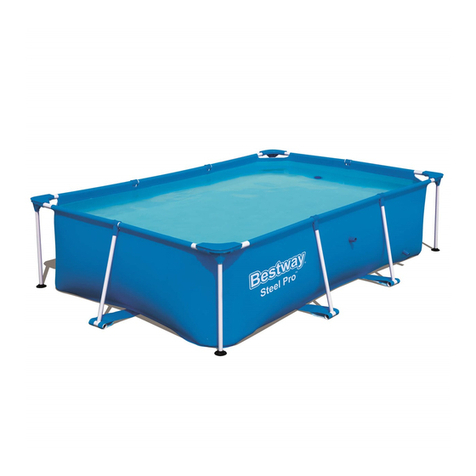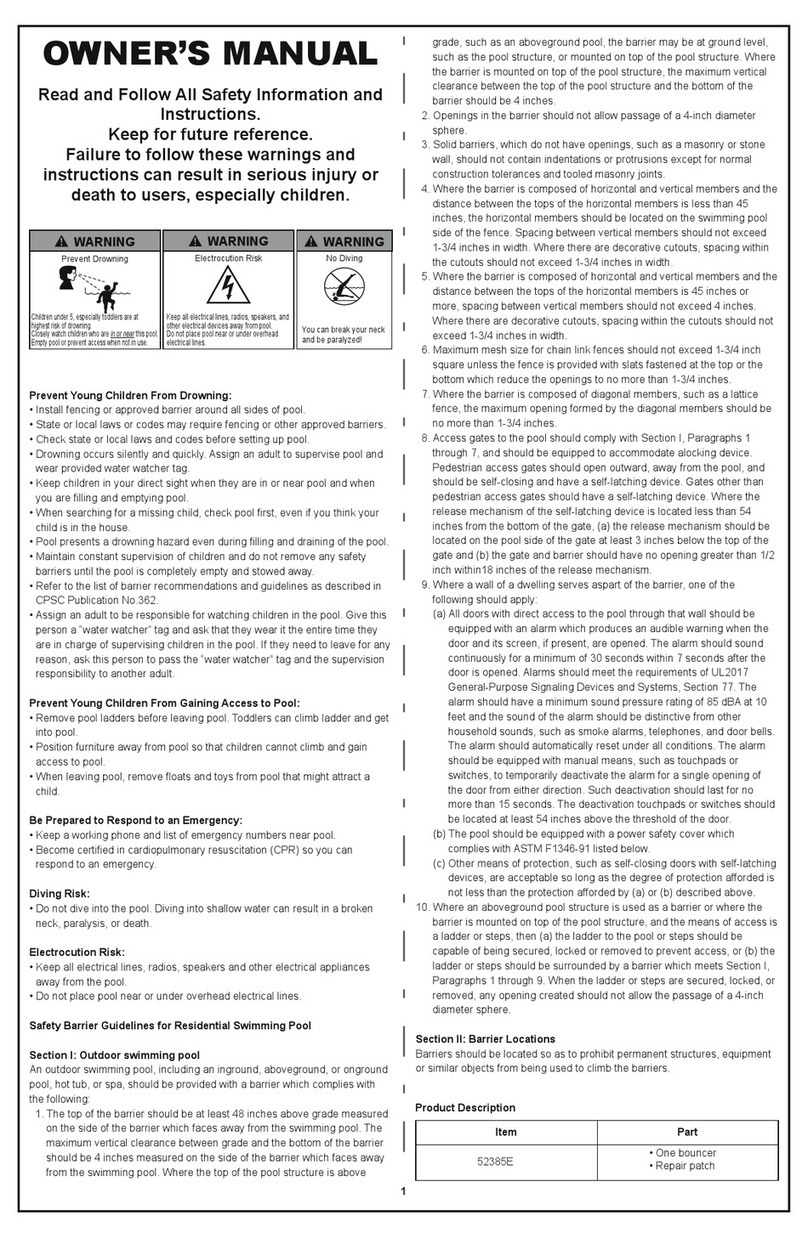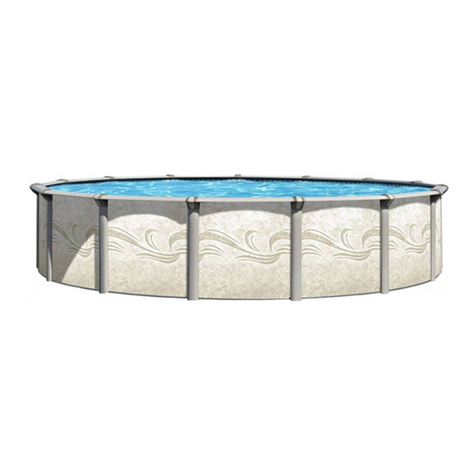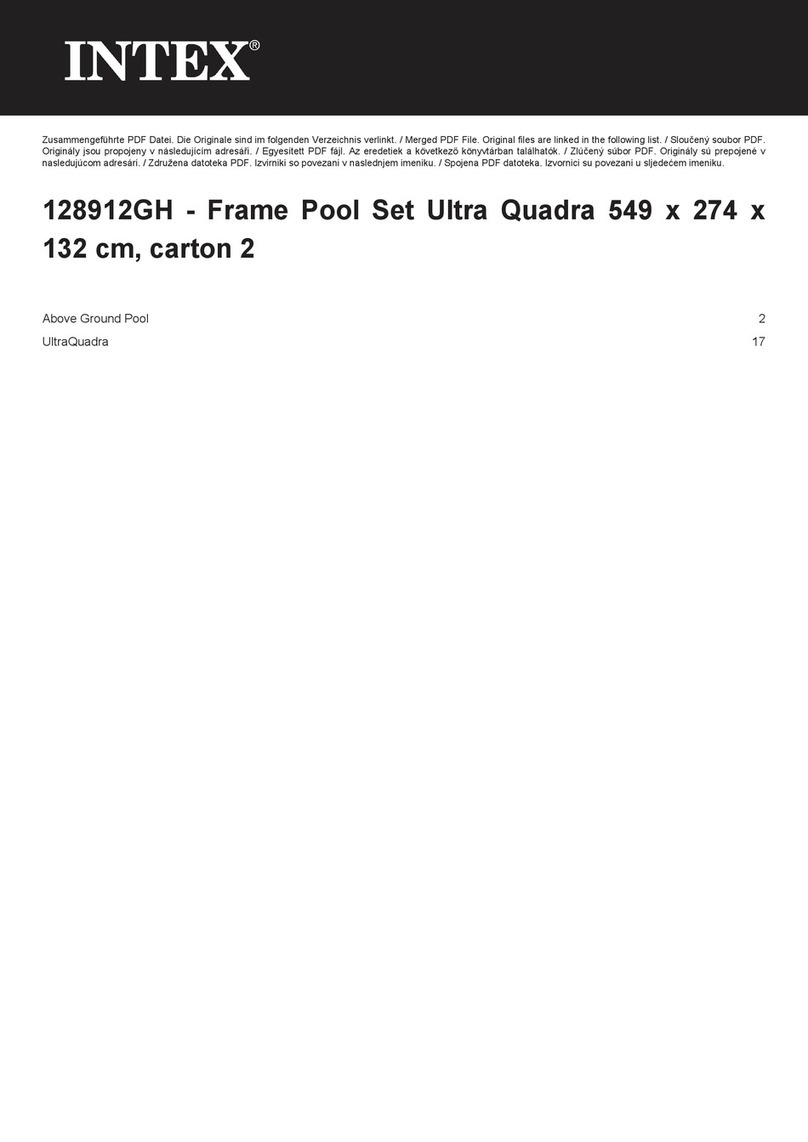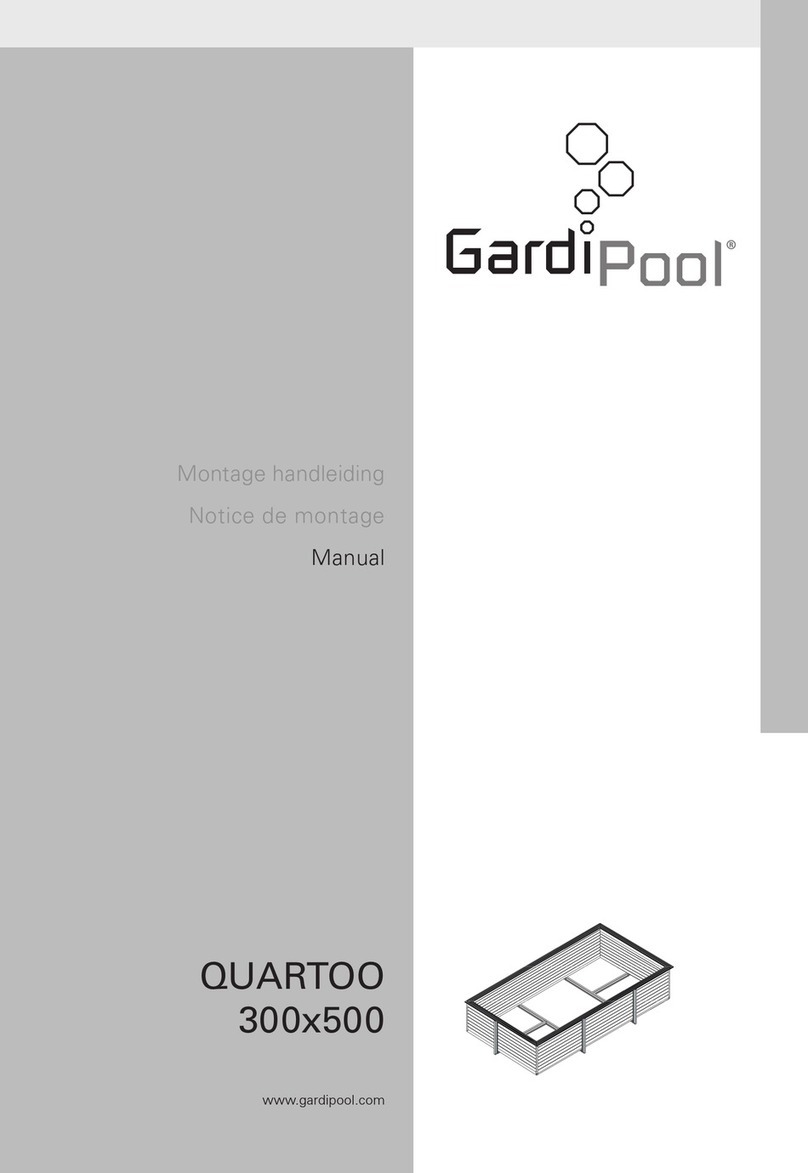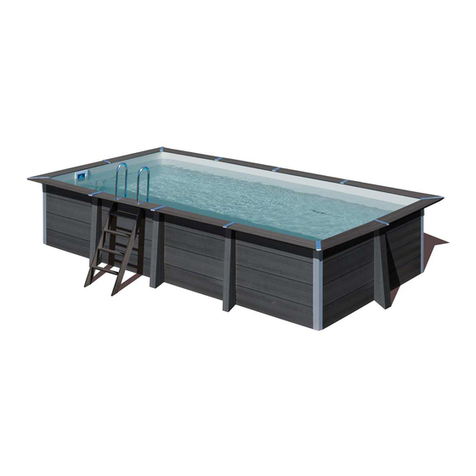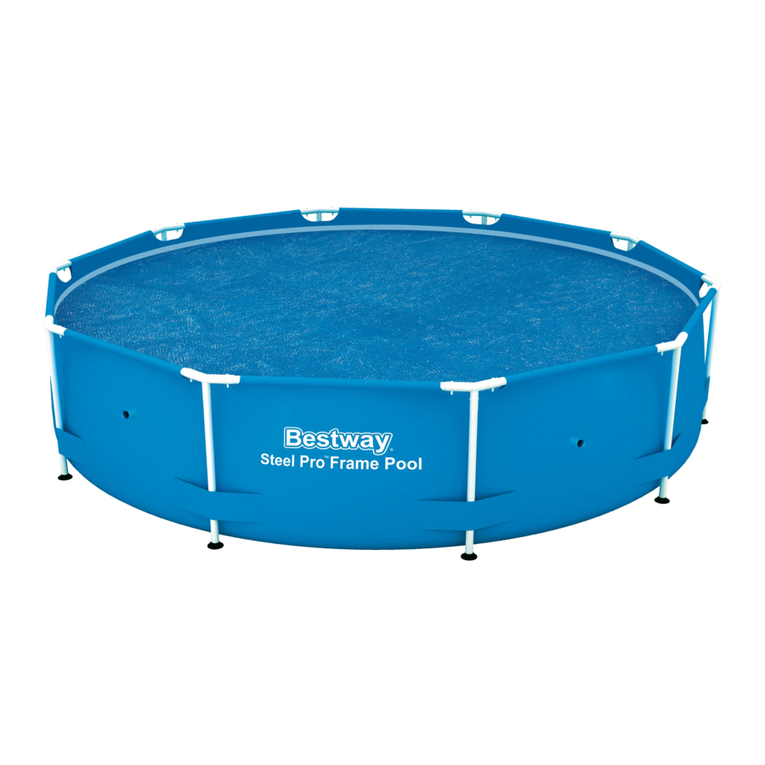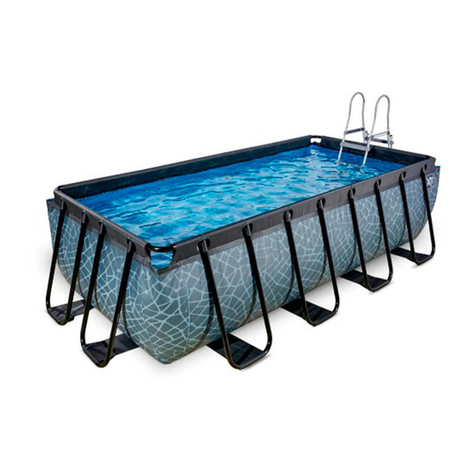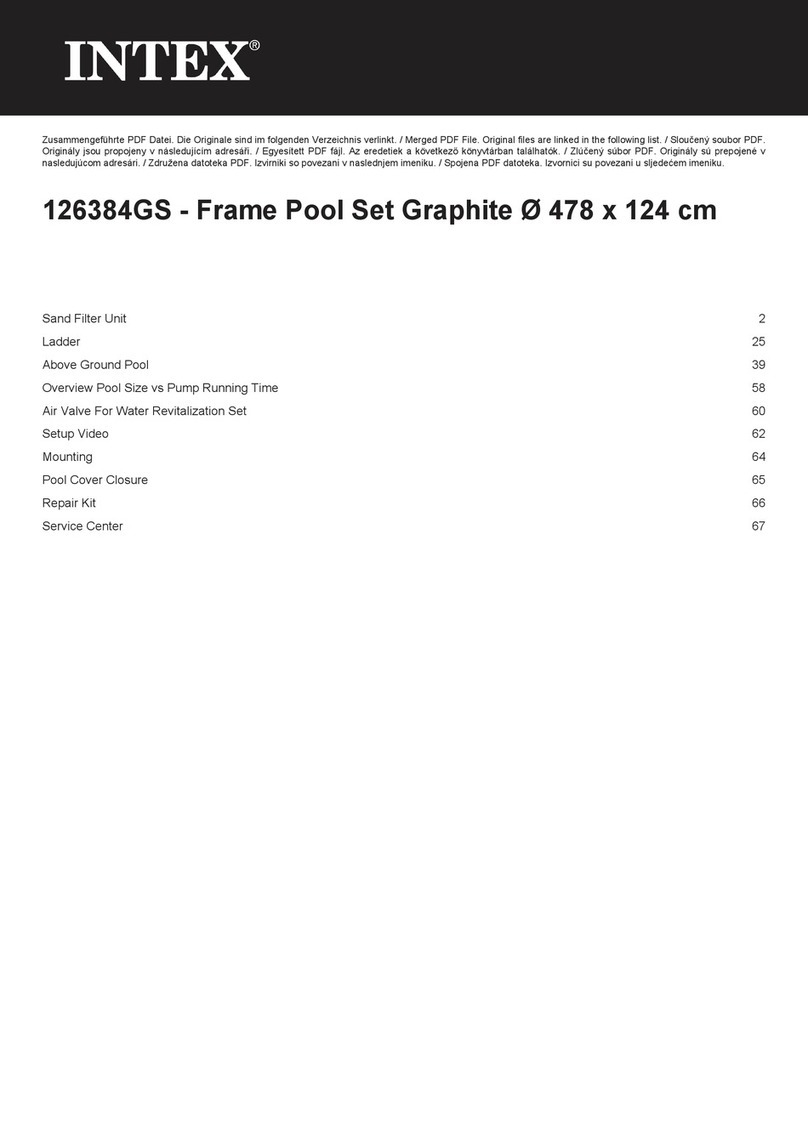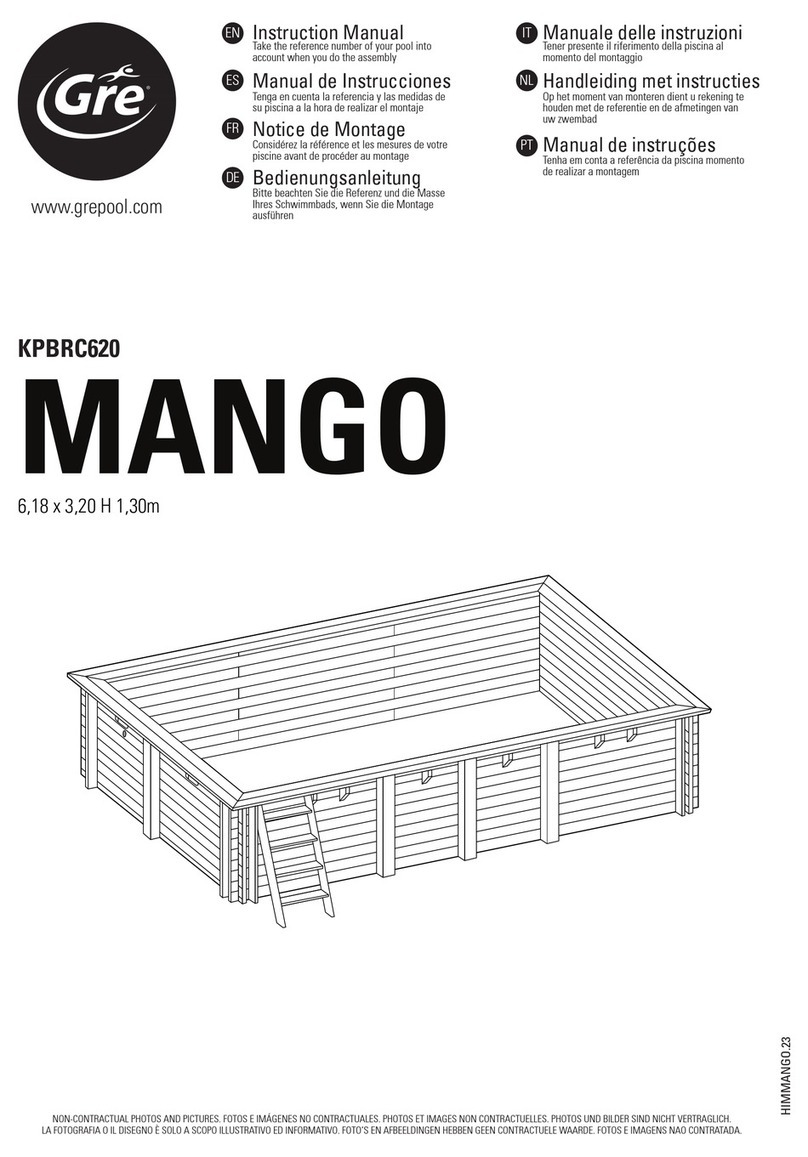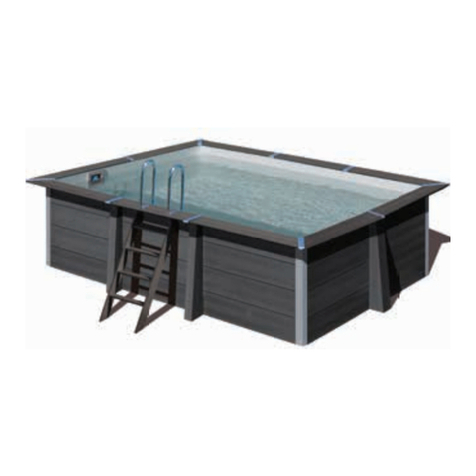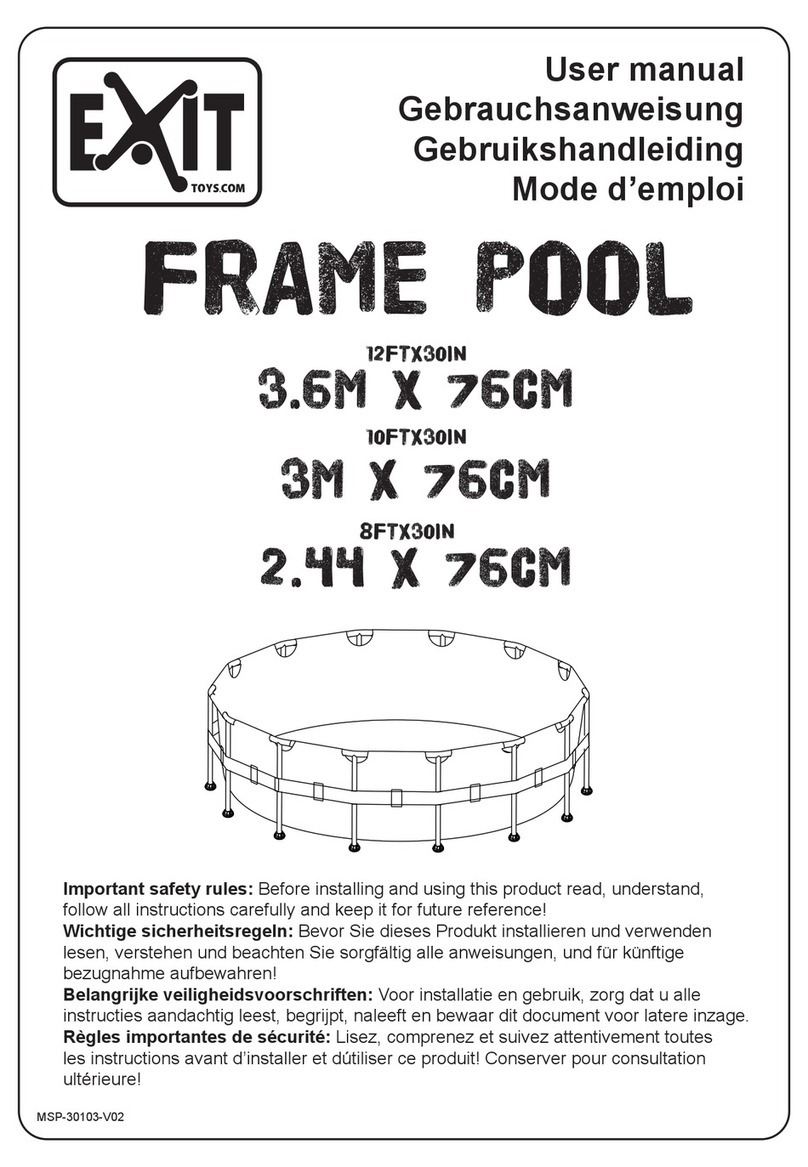Bespoke Channel Lok-II User manual

No Diving or Jumping. Observe all Safety Rules.
1-1
Sunray - Channel Lok-II
Oval Pools
❏Part No. 1920583 rev. 0
1
Pool Component Installation
Manual
General Instructions
SECTION
Safety Rules For Pool Owners
This manual must be left with the pool owner
Your pool contains a large quantity of water, and is deep enough to present inherent
dangers to life and health unless the following safety rules are strictly observed. First-
time users run the highest risk of injury. Make sure everyone understands all safety
rules before entering the pool. Post NO DIVING and NO JUMPING signs beside the pool.
For additional safety information please read the enclosed booklet The Sensible Way
To Enjoy Your Aboveground/Onground Swimming Pool.
1. No Jumping or Diving
The top rail of your pool is not a walkway and must not be used for jumping or diving.
Do not permit jumping or diving into the pool from a deck or the top rail of the pool.
Diving or jumping into the pool can result in serious injury.
2. Never use the Pool Alone
Never permit the pool to be used unless it is attended by at least one person other than
the bather. Someone should always be available to lend assistance in an emergency.
3. Never Leave Children Unattended
Never leave a child alone and unsupervised in or near the pool—not even for a sec-
ond. There is no substitute for constant adult supervision.
4. No “Rough-housing”
Do not permit “rough-housing” in and around your pool. Surfaces can become slippery
and hazardous when wet.
5. Light the Pool at Night
If the pool is used after dusk, adequate lighting must be provided. Illumination in the
pool area must be sufficient to clearly judge pool depth and all features in and around
the pool. For lighting recommendations, consult your local licensed electrical
contractor.
6. Restrict Access to the Pool
Do not leave chairs or other furniture beside the pool that could be used by a child to
climb up into the pool. Ladders must be removed whenever the pool is unattended. A
fence with a lockable gate around the pool or yard is strongly recommended and may
be required by law in some jurisdictions.
7. No Alcohol or Drugs
The use of alcohol or drugs does not mix with pool activities. Persons who have been
drinking alcohol or using any drugs should not be allowed in the pool, and should be
carefully supervised in the surrounding area.
8. Keep Your Pool Clean and Sanitary
Your filter system will remove suspended particles from the water and the surface
skimmer will remove insects, leaves and other debris from the water surface. Use the
correct pool chemicals as directed to destroy harmful bacteria and prevent formation
of algae. Remember, unsanitary water is a serious health hazard.

No Diving or Jumping. Observe all Safety Rules.
A. Introduction to Installing your Pool
Read all instructions completely before you begin.
These instructions explain how to install your pool. Simply follow the step-
by-step directions. Start with this part, SECTION 1 and use the other instruc-
tions, SECTION 2 to 4to put together your entire pool.
SECTIONS 1, 2 and 3have information for several different pool sizes and
styles; follow the instructions carefully to make sure you use the informa-
tion that apply to your specific pool.
SECTION 1 also has Safety Rules and instructions to help you keep your
pool clean and in good shape, year after year. Be sure to read the Safety
Rules, and make sure everyone who uses your pool reads and under-
stands them.
B. Determine a Location for your Pool
1. The Terrain
Pay special attention to choos-
ing the right location for your
pool:
• Choose a large area, as flat
and level as possible.
• Choose a spot on dry, firm
earth—do not install the pool
on asphalt, tar paper, sand,
gravel, peat moss, wood or
chemically treated soil.
• Check with your pool dealer
to see if Nut Grass grows in
your area. This type of grass
may grow up through your
pool liner. Your dealer will be
able to advise how best to
treat the site.
• Sloped areas will need to be
made level by digging away
high spots, not by filling low
spots—be prepared to hire
earth-moving equipment if
necessary.
1
2 3
4
1-2
!
Important Note:
This pool has been designed to allow for installation on a level concrete pad. The pad must be a mini-
mum of 3" (8 cm) thick and poured onto solid undisturbed ground.
Note: A brick sand or styrofoam bottom & a brick sand or fine earth cove still must be installed over the
concrete foundation to protect the liner. This is detailed in Section 2 of the pool frame installation
manual.
!
Important Note:
Ground prepara-
tion is one of the
most important
steps in the instal-
lation process. A
proper foundation
will ensure the rest
of the pool assem-
bly goes smoothly
and that no prob-
lems will occur
when the pool is
filled with water.
Open all of the
frame cartons and
read all of the
instructions before
you begin. Be sure
to read Section 2
and get a com-
plete overview of
the pool base and
buttress assembly
before starting the
ground prepara-
tion.

No Diving or Jumping. Observe all Safety Rules.
2. Things to Avoid
Do not locate your pool near or
on any of the following:
• Overhanging tree branches.
• Overhead wires, clotheslines.
• Buried pipes and wires—
contact your gas, electric and
telephone utilities to find
buried pipes and wires
before you dig.
• Hilly and uneven terrain.
• Areas with poor drainage.
• Grass, stones and roots. Grass
will rot underneath the pool
liner, and stones and roots
will damage the pool liner.
• Areas recently treated with oil-based weed killers, chemicals or ferti-
lizers.
3. Plan Ahead
• Will you be adding an adjacent deck later? Be sure to leave room.
• Will you be using pool accessories or other appliances that need
electricity or gas? Locate your pool near these services or plan to
have them installed later by a licensed contractor.
C. Prepare the Foundation of your Pool
1. Choose the Correct Ground Preparation Drawing
a. Choose the drawing that matches your pool size from the five plan
drawings below. This drawing will have all of the necessary dimen-
sions for the ground preparation instructions that follow.
1-3
15 x 30 Oval Pool
Dimensions
R90" (229 cm)
S102" (259 cm)
L90" (229 cm)
M30-1/2" (77 cm)
N59-1/2" (151 cm)
P180" (457 cm)
W134" (340 cm)
X90" (229 cm)
Y127-1/4" (323 cm)
Z161-1/2" (410 cm)
BB
G
G
KJ
HI
R
R
S
S
X
XY
YZ
Z
N
NMM
P
P
L
L
F
F
E
EDD
A
A
C
C
W
W
Measuring StakesMeasuring Stakes
Centre PointCentre Point
CentrelineCentreline
Pool AreaPool Area
Pool WallPool Wall
Clearance AreaClearance Area
!
Important:
When locating the
centreline of the
pool, be sure to
take into consid-
eration any struc-
tures (deck, patio,
house) or relevant
items (change
rooms, gazebo,
etc.) that the pool
may need to line
up with and en-
sure that the pool
is in the most
visual pleasing
location for your
property.
5 6
7

No Diving or Jumping. Observe all Safety Rules.
1-4
15 x 24 Oval Pool
Dimensions
R90" (229 cm)
S102" (259 cm)
L54" (137 cm)
M30" (76 cm)
N48" (122 cm)
P108" (274 cm)
W134" (340 cm)
X90" (229 cm)
Y105" (267 cm)
Z144-1/2" (367 cm)
12 x 24 Oval Pool
Dimensions
R72" (183 cm)
S84" (213 cm)
L72" (183 cm)
M24" (61 cm)
N48" (122 cm)
P144" (366 cm)
W116" (295 cm)
X72" (183 cm)
Y101-3/4" (258 cm)
Z136-1/2" (347 cm)
12 x 18 Oval Pool
Dimensions
R72" (183 cm)
S84" (213 cm)
L36" (91 cm)
M36" (91 cm)
P72" (183 cm)
W116" (295 cm)
X72" (183 cm)
Y80-1/2" (204 cm)
Z121-1/2" (309 cm)
BB
G
G
R
R
S
S
X
XY
Y
N
NMM
P
P
L
L
F
F
E
EDD
A
A
C
C
KJ
HI
Z
ZW
W
Measuring StakesMeasuring Stakes
Centre PointCentre Point
CentrelineCentreline
Pool AreaPool Area
Clearance AreaClearance Area
Pool WallPool Wall
BB
G
G
R
R
S
S
X
XY
Y
N
NMM
P
P
L
L
F
F
E
EDD
A
A
C
C
KJ
HI
Z
ZW
W
Measuring StakesMeasuring Stakes
Centre PointCentre Point
CentrelineCentreline
Pool AreaPool Area
Clearance AreaClearance Area
Pool WallPool Wall
BB
G
G
R
R
S
S
X
XY
Y
M
M
P
P
L
L
F
F
E
EDD
A
A
C
C
KJ
HI
Z
ZW
W
Measuring StakesMeasuring Stakes
Centre PointCentre Point
CentrelineCentreline
Pool AreaPool Area
Clearance AreaClearance Area
Pool WallPool Wall

No Diving or Jumping. Observe all Safety Rules.
2. Mark out the Area
a. Drive two pegs (A) and (B) into
the ground. These pegs will
both be on the centreline of
your pool. Choose the right
distance between them from
the chart below. Note: Dis-
tance Ato Bis equal to di-
mension Pon the pool draw-
ings above.
Pool Size Distance between two pegs (A) and (B)
12' x 18' 72" (183 cm)
12' x 24' 144" (366 cm)
15' x 24' 108" (274 cm)
15' x 30' 180" (457 cm)
18' x 33' 180" (457 cm)
b. Use a length of string tied
between peg (A) and a can of
spray paint, and mark a
circle on the ground. Next, do
the same for peg (B). Choose
the length of string you need
for your pool from the chart
on the next page. The circles
will be 12" (30 cm) bigger all
round than the pool.
1-5
8
18 x 33 Oval Pool
Dimensions
R108" (274 cm)
S120" (305 cm)
L90" (229 cm)
M30-1/2" (77 cm)
N59-1/2" (151 cm)
P180" (457 cm)
W152" (386 cm)
X108" (274 cm)
Y140-5/8" (357 cm)
Z176-5/8" (449 cm)
BB
G
G
R
R
S
S
X
XY
Y
N
NMM
P
P
L
L
F
F
E
EDD
A
A
C
C
KJ
HI
Z
Z
WW
Measuring StakesMeasuring Stakes
Centre PointCentre Point
CentrelineCentreline
Pool AreaPool Area
Clearance AreaClearance Area
Pool WallPool Wall
B
A
Size of foundation area
Size of pool
12" (30 cm)
9
!
Important:
Determine the
location of your
pool. Make sure
you have the
proper distances
away from any
adjacent
structures (i.e.
fences, house etc.).
Contact local
authorities for this
information and
any additional
requirements
governing the
installation of a
pool in your area.
By using the dis-
tances provided
by local
authorities and
adding them to
dimension Sfrom
the drawings
above, you can
calculate the
location of the
centreline of the
pool.
This manual suits for next models
3
Table of contents
